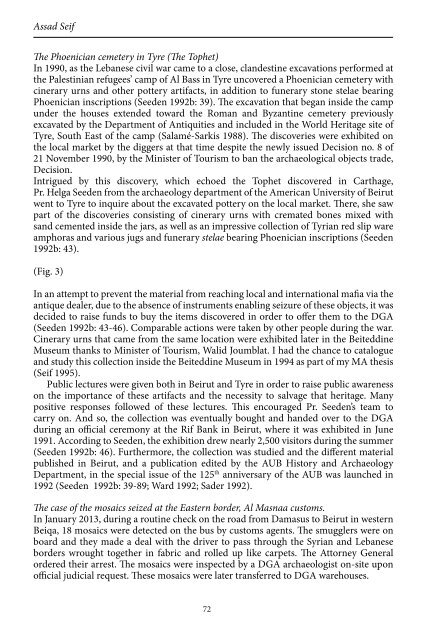Countering
Book_observatory_illicit_traffic_version%20issuu
Book_observatory_illicit_traffic_version%20issuu
Create successful ePaper yourself
Turn your PDF publications into a flip-book with our unique Google optimized e-Paper software.
Illicit Traffick in Cultural Property in Lebanon<br />
The police report stated that the mosaics originated from Syria. Furthermore, their<br />
North Syrian origin was determined from their type and the nature of the scenes<br />
depicted. Official request for an expertise on the mosaics seized was thus submitted to<br />
the Directorate General of Antiquities and Museums (DGAM) in Damascus. Later on,<br />
the DGA received a team of DGAM mosaic experts, who identified the mosaic and<br />
ascertained their origin. The detailed examination of the mosaics revealed, however,<br />
revealed that some of them were fakes, and they were inserted within the lot in order<br />
to increase the number and get better prices. A committee from both countries was<br />
formed in order to prepare the repatriation of these mosaics. Then official restitution and<br />
repatriation occurred in early 2013. Two police cars escorted the truck transporting the<br />
mosaics from the DGA warehouse to the Lebanese eastern borders.<br />
The fake manuscripts case<br />
Two members of the Police force disguised as potential buyers arrested a dealer within<br />
Lebanese territory who was offering to sell old manuscripts, which he claimed were<br />
brought from a public library in Syria. These manuscripts had Ottoman certifications<br />
and Ottoman official papers indicating their nature (a Bible and a Qu’ran), marked<br />
with the official stamp of the last Ottoman Sultan, Abdul Hamid II. Once authorities<br />
had proceeded with the required arrests and seizure of objects, the manuscripts were<br />
transferred to the DGA who sent them for conservation and authentication to one of<br />
the most important paper conservation university labs in the country. Once a textual<br />
and paper expertise was carried, specialists declared that the manuscripts were fakes or<br />
counterfeit. These manuscripts are now held in the DGA’s fake requisitions collection – a<br />
reference collection for any potential future use and comparison.<br />
(See Figs. 4-5)<br />
The case of stolen objects from Apamea and Palmyra.<br />
In May 2013, the DGA received an email from the UNESCO Cultural Heritage Protection<br />
Treaties Section Office, indicating that dealers from Beirut are proposing objects for<br />
sale from Palmyra on the European market. The information was sent directly to the<br />
Ministry of Interior’s dedicated department, so that the proper procedures might be<br />
carried out. At the same time, the general security department was following an inquiry<br />
done by a journalist on illicit traffic of cultural objects from Syria. Information from<br />
both sides confirmed the location of the objects in the southern suburb of Beirut. After<br />
first inspection of the area by the general security forces, they located a shop which was a<br />
normal flea market shop selling traditional antiques and there were additional exhibited<br />
objects of archaeological nature.<br />
Since the number of mixed items (archaeological and fake) exhibited was enormous,<br />
and since the security forces did not have experts to identify the real from the fake, a<br />
decision was taken to get an expert from the DGA with the Hit Team that is to seize<br />
the merchandise. The expert’s mission is to identify the real objects that will be seized.<br />
In fact, the intervention of the security forces on the ground had to be quick, since the<br />
objects seized had quickly been transferred to a truck. Furthermore, the number of<br />
objects in the shop was huge and could not fit in one truck. Consequently, a selection<br />
process had to be made in order to seize and move the real objects at once before the<br />
situation escalated on the ground.<br />
73


